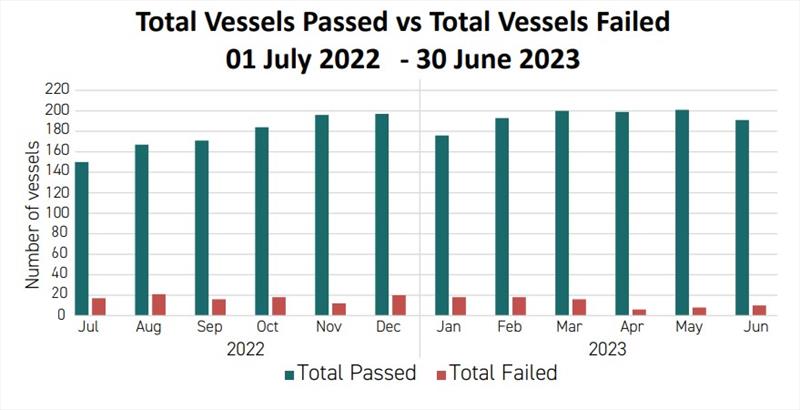
Craft Risk Management Standard for biofouling - The Figures
by MPI NZ 4 Oct 2023 22:10 UTC

Total vessels passed vs Total vessels failed © MPI NZ
Please note that the biofouling statistics and graphs in this issue have been altered to align with the beginning of the month as we are transitioning to monthly reporting to make the figures more accessible to stakeholders. Statistics in this issue run from 1 April - 30 June.
Biofouling Assessment
Biofouling documentation assessment commenced in 2018, after a four-year lead in period of the Craft Risk Management Standard for biofouling. Following this, vessels visiting New Zealand were moved onto an assessment schedule. Biofouling assessments are triggered by:
- time elapsed since last assessment.
- increase in risk level e.g. long lay-ups since previous assessment.
- vessel's first arrival to New Zealand.
- internal assessment after the receipt of new paperwork.
- vessels returning with active Notice of Direction (NOD), or previous assessment failures are reassessed on return.
It is important to be aware that a failed assessment does not mean a vessel will be denied entry into New Zealand. Biosecurity NZ's response will always be in proportion to the biofouling risk of the vessel. There are many steps you can take to increase the likelihood of passing your assessment.
Compliance actions
A NOD is issued by Biosecurity NZ when a vessel fails to show compliance with the Standard. NODs list the compliance actions a vessel must follow to manage the biofouling risk that they pose to New Zealand. These will always be in proportion to the risk the vessel poses. For instance:
- lower risk vessels may be allowed to complete their declared itinerary.
- high risk vessels may be directed to leave NZ in less than 24 hours.
- in circumstances where the risk is unclear, a vessel may be directed to undertake a hull inspection.
There has been a decrease in the number of NODs issued in the current quarter compared to the previous quarter. This is great to see. MPI appreciates the effort being made by the shipping industry during the last quarter and we hope to see it continue through the rest of the year. If you would like any assistance, please feel free to contact us at: .